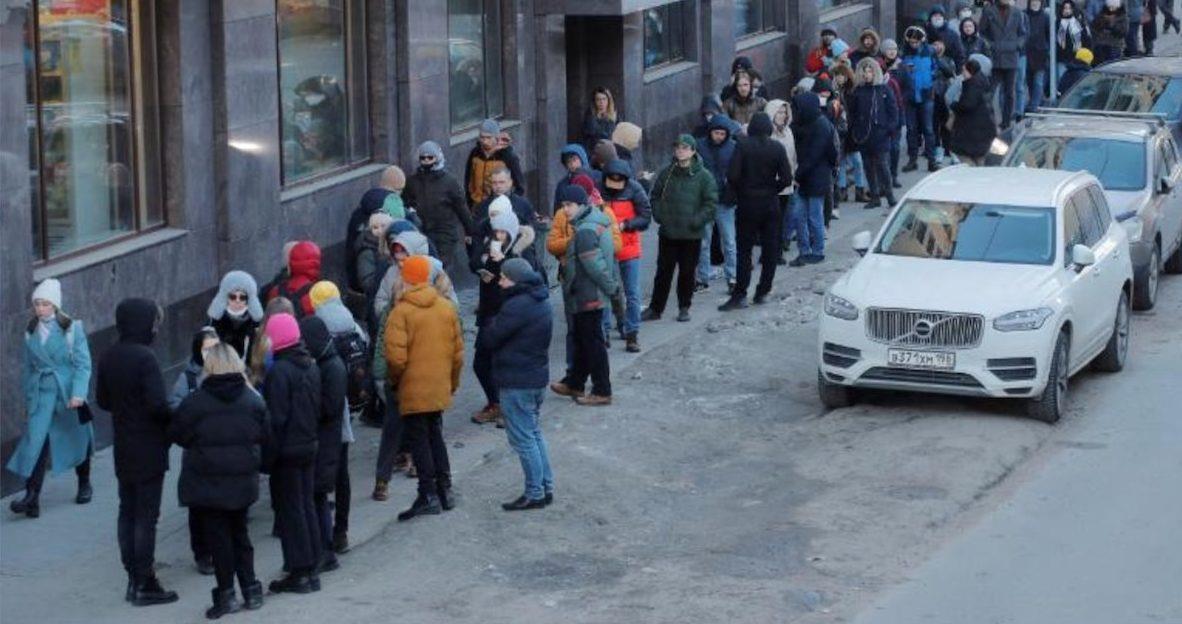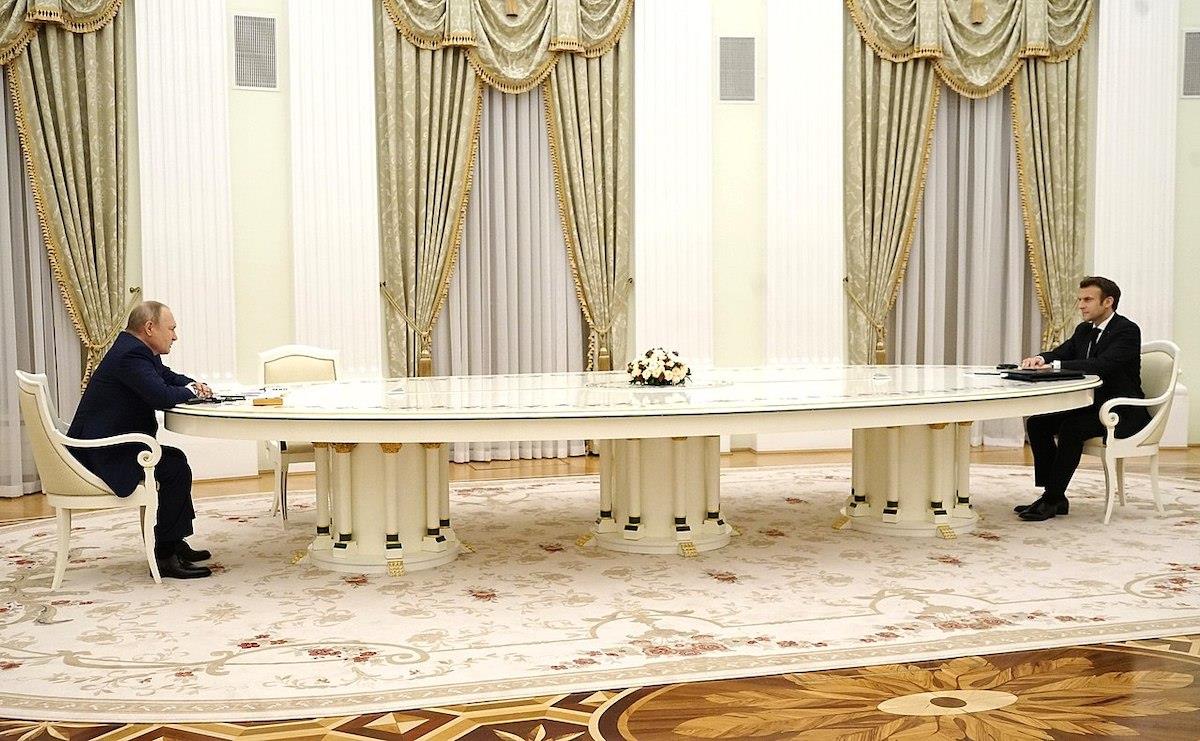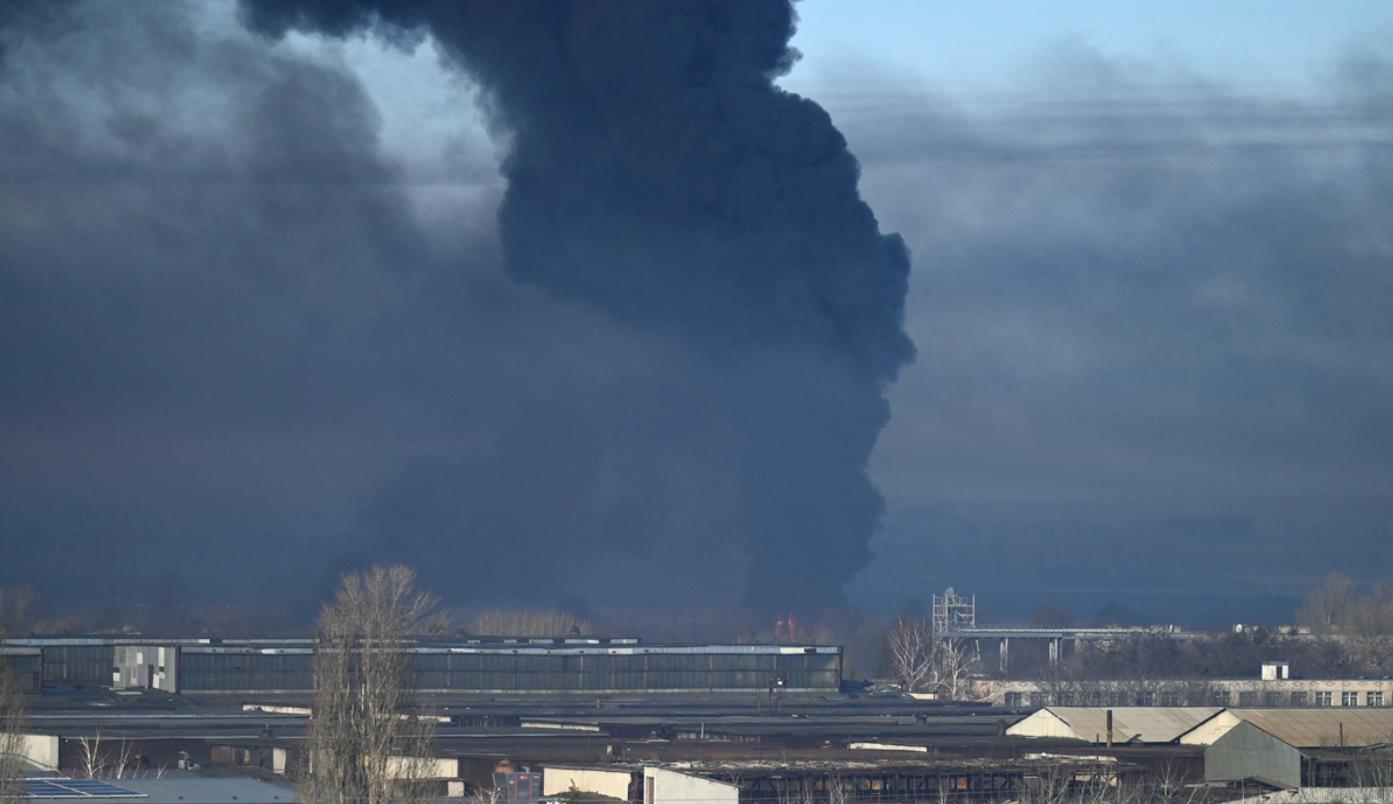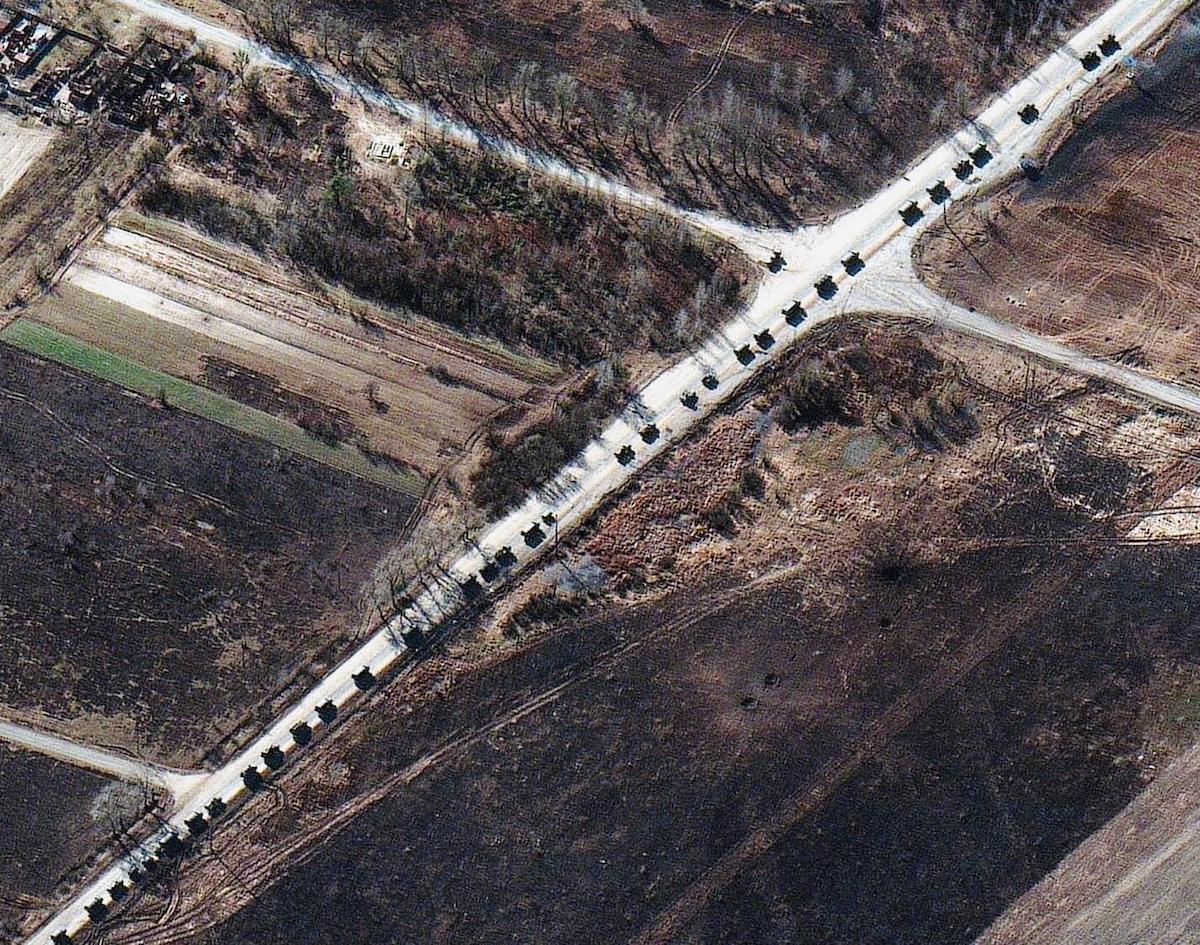(MENAFN- Asia Times)
Kiev's leadership had low expectations beforehand, and bilateral peace talks on Monday failed to reach an agreement, meaning military activity continued uninterrupted as Russian attackers stepped up their operations across Ukraine.
Recent reports from on the ground do not favor the defenders. Russia is expanding the territory it has captured in the south of the country, but the more critical developments are in the north and northeast.
Forebodingly for the Ukrainian resistance, a huge concentration of Russian forces was forming northwest of the capital Kiev on Tuesday. This force, which at the time of writing does not yet appear to have started its advance, looks set to surround and lay siege to the city.
And in the strategic flashpoint city of Kharkiv, Ukraine's second-largest city, the violence has been ratcheted up with rocket artillery and possibly cluster bombs being unleashed on civilian areas, reportedly killing dozens. Ukrainian President Volodymyr Zelensky has called the strikes a“war crime.”
But the pain is not only on the Ukrainian side. Russia, too, has been incurring heavy damage on the home and global opinion fronts. Even so, Russian President Vladimir Putin is not withdrawing his demands that Ukraine demilitarizes and takes on a status of permanent neutrality.
In fact, in discussions with French President Emanuel Macron on Monday, Putin upped the ante.
West expands counterattack
While NATO has repeatedly made clear it will not fight in or for Ukraine, Russia's“special military operation” has been met with a multi-pronged hybrid response that is countering Kremlin hard power.
A financial offensive is hammering Russia, resulting in the ruble plunging in value by over 30%. President Putin has, in capital control orders that take effect on Tuesday, forbidden Russians from moving foreign currency out of the country.
Major Russian banks have been severed from the global SWIFT transaction system, but according to a Russian banking source , Visa and Mastercard are still working in Russia, leading to calls from the Ukrainian Central Bank for the card firms to cut off Russian services.

Russians line up to withdraw money from ATMs in Moscow as sanctions start to bite. Photo: Facebook
On Monday, Bitcoin saw a nearly 10% surge in value , reflecting expectations that sanctioned Russian financial players can or will use the cryptocurrency to transfer assets across borders under the radar of institutions.
Energy firms are taking sides. Anglo-Dutch oil giant Shell has followed BP in announcing its divestment of Russian businesses , including the NordStream II pipeline and a joint venture with Russian flagship Gazprom. Norway's Equinor will reportedly do the same.
Major car firms , including GM, Volvo and Daimler Truck, are also halting vehicle exports to Russia, or, like Mercedes, seeking to divest their Russian arms.
Western media firms, old and new, are joining in.
Disney, Warner Bros and Sony are halting the release of new films in Russia . And in an oddly old-fashioned censorial response, Meta said it will restrict access to Russia's pro-Kremlin media RT and Sputnik on Facebook in Europe, while Twitter said it would tag Tweets linked to Russian state media.
On Sunday, the EU announced a ban on Sputnik and RT broadcasting across the bloc.
Entrepreneur Elon Musk has supplied Starlink satellite equipment to Ukraine, which should enable Ukrainians to have internet access even if wireless relay stations and fiber optics are destroyed.
However, an apparent cyberattack by unknown assailants that took down Russian news agency Tass' website on Monday has apparently been repelled, with the site back up and online at the time of writing.
And Western celebrities, including actor Benedict Cumberbatch, author Stephen King, singer Barbara Streisand and even the future king and queen of the UK – have all expressed support for Ukraine.
All the above makes it clear how vital control of the narrative around this war is in newspapers, broadcasts and the internet. This would appear to be a Russian vulnerability, for while the well-armed and mobile attackers continue to dictate events on the ground, on social media, the Ukranian defenders are punching above their weight.
The social media war
When a brilliant and largely bloodless operation to swiftly seize Crimea was conducted in 2014, Russian troops were advancing into an area predominantly inhabited by Russians.
But now, as they advance across far larger swathes of territory where ethnic Ukrainians are the majority, Russian soldiers are facing hostility in spheres that are not restricted to old-school combat and against a population that is more tech- and media-savvy than prior opponents in Syria.
Ukraine leader Zelensky – a former comedian and actor – is emerging as the star of this conflict.
His messaging adroitly blends defiance and victimhood, while urging the West to do more. In a move that appears designed to show that Ukrainians are in synch with European values and lifestyles, he appealed for immediate EU membership, posting a signed application online.
“Our goal is to be with all Europeans,” he said.

Vladimir Putin prefers to keep his critics at arm's length, or more, while in the Kremlin for talks, this time with French President Macron. Recent shots of Zelensky show him on the streets with his people. Photo: WikiCommons
His close-up, businesslike addresses from his besieged capital Kiev, dressed in khaki and unshaven, contrasts strongly with the image disseminated by his opponent. Stage-managed television scenes show a besuited Putin sitting isolated from his interlocutors at a comically large table in a vast Kremlin hall.
In an era when every citizen is a journalist, every citizen in a conflict zone is a potential propagandist for his or her cause. Ukrainians have smartphones in a theater where Russia's vaunted cyber attacks have not – at least, not yet – cut power, telecommunications or internet networks and much of the carnage is being captured and broadcast across globally used social media platforms.
The horde of witnesses puts restraints on the conduct of Russian troops – particularly in the face of unarmed, civilian resistance.
In the South, where according to photos distributed by Western intelligence agencies, Russian forces have made their largest territorial gains, footage from the city of Berdyansk shows large crowds confronting fully armed, but apparently nonplussed Russian troops outside the town's city hall.
Many similar scenes have also been captured and distributed on social media – unarmed civilians barring passage to vehicles, including tanks, arguing with dismounted troops and joking at the expense of stalled convoys.
Putin has strongly promoted military values among the Russian population and has upgraded the conditions, equipment and professionalism of the Russian armed forces.
But in Ukraine, footage of Russian military incompetence is being widely distributed. In one such clip, a Russian armored personnel carrier runs over a civilian car. Why the troop carrier ran over the car, and why it was not part of a formed unit, is unknown.
Other clips have shown Russian troops lost or stranded, out of fuel. Footage of captured Russian prisoners indicates that many thought they were going to Ukraine to exercise, not fight.
Yet there are disturbing signs that Russian commanders are taking the gloves off.
Escalating lethality
Total air superiority and the extensive use of airpower has long been the key feature of US combat operations. The Russian armed forces do not have access to as much funding as their US counterparts, but the Russian army, and its predecessor the Red Army, has always been heavily artillery centric.
Russian combined-arms battalion groups customarily deploy more artillery than western battlegroups and also rely more on multiple rocket launch systems, or MLRS, which can deliver more explosives in a shorter time than tube artillery batteries.

Black smoke rises from a military airport in Chuguyev near Kharkiv, Ukraine, on February 24, 2022. Photo: Screengrab / VCG
From the strategic city of Kharkiv, footage taken by civilians and uploaded to social media show what appear to be clusterbomb and MLRS strikes in the city. These tactical, area weapons, designed for use against infantry concentrations, are very different munitions from the precision missiles used to take out specific targets, which were widely seen in the first days of the Russian assault.
If the use of such weapons becomes more widespread in urban areas, it would indicate that Russian commanders are easing the rules of engagement and dialing up the level of firepower against urban populations. This heavy use of indiscriminate firepower has been clear in deadly and destructive Russian operations in Chechnya and Syria.
So far, questions over Ukrainian national morale appear to have been answered.
In addition to the unarmed resistance, some territorial defense units are seeing so many volunteers that some men are being turned away. Footage of civilians of both genders preparing Molotov cocktails – which are effective when hurled onto the decks of vehicles from above, such as from windows – are widespread.
But not every man is flocking to the colors. BBC news reports from the western Ukrainian city of Lviv show tense scenes of Ukrainian personnel permitting women and children to leave, but not young men of military age.

According to satellite provider Maxar, the Russian convoy stalled to the north is 40 miles long. Photo: Facebook
The gathering storm
It is far from clear how long the civilian will to resist can be maintained if Russian mobile forces surround and lay siege to Kiev, cutting off power and restricting food supplies into the city of 2.8 million.
The force to do that looks to be preparing for the decisive offensive in this multi-sided war. A 60-kilometer long convoy of forces, which has expanded massively in size since Monday – is poised approximately 30 kilometers northwest of Kiev.
It is unclear whether its slow progress is due to resistance further south, or – more likely – because it is still gathering force while coordinating its order of march. Satellite photos show units lined up in a tight column – appropriate for road transit – rather than deploying teeth units offroad in the kind of formations that are appropriate for combat or advancing to contact.
According to information received by Asia Times , Russia plans to invest the capital, thereby forcing its capitulation or, failing that, the annihilation of its defenders. And according to Russian media reports, the road south of Kiev has been left open to allow a civilian exodus from the city.
Despite widespread demonstrations against the war across Russia, the country's expanding international isolation and rising levels of discomfort and dissatisfaction among ordinary Russians due to the conflict and sanctions, there is no indication that Putin's power is being eroded, nor that his determination is wavering.
Speaking on Monday in a 90-minute telephone conversation with French President Emanuel Macron Putin repeated his demands that Ukraine becomes a demilitarized neutral country. But he also added a demand long denied by Western nations, that the global community recognizes his 2014 takeover of Crimea.
MENAFN01032022000159011032ID1103781962